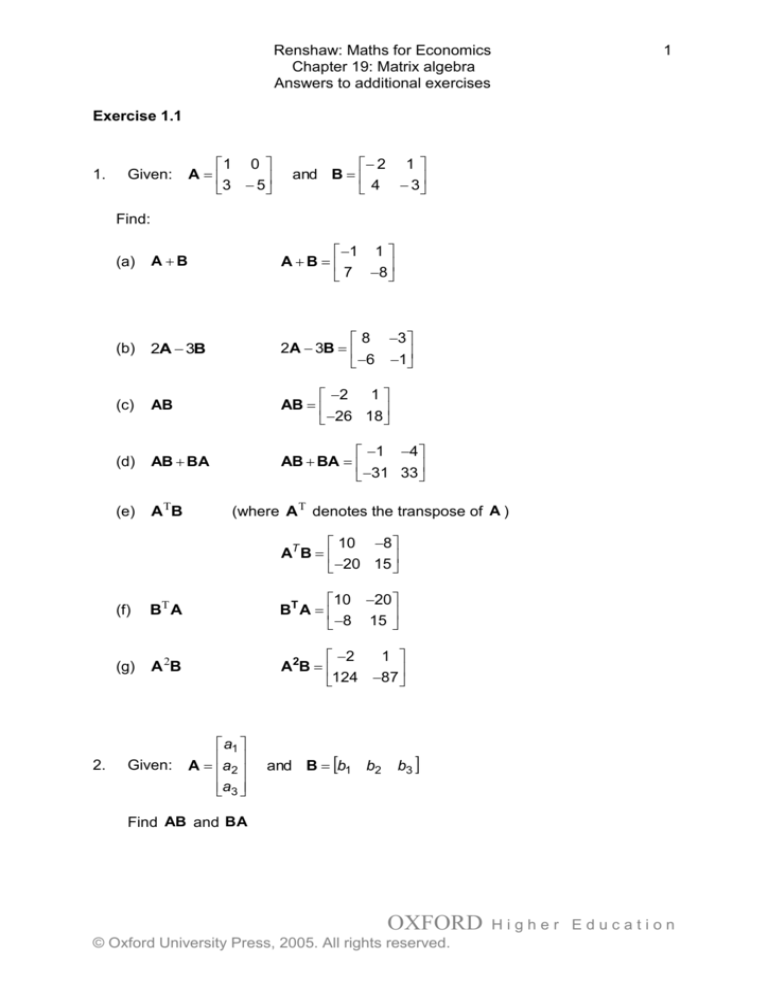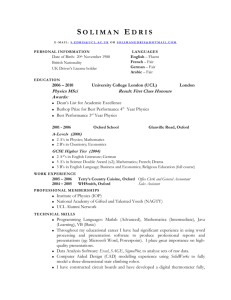
Renshaw: Maths for Economics
Chapter 19: Matrix algebra
Answers to additional exercises
1
Exercise 1.1
1.
Given:
1 0
A
3 5
2 1
and B
4 3
Find:
(a)
A B
1 1
A B
7 8
(b)
2A 3B
8 3
2A 3B
6 1
(c)
AB
2 1
AB
26 18
(d)
AB BA
1 4
AB BA
31 33
(e)
A TB
(where A T denotes the transpose of A )
10 8
AT B
20 15
2.
(f)
BT A
10 20
BT A
8 15
(g)
A 2B
1
2
A2B
124 87
Given:
a1
A a2
a3
and B b1 b2
b3
Find AB and BA
OXFORD
© Oxford University Press, 2005. All rights reserved.
Higher Education
Renshaw: Maths for Economics
Chapter 19: Matrix algebra
Answers to additional exercises
2
a1b1 a1b2 a1b3
AB a2b1 a2b2 a2b3
a3b1 a3b2 a3b3
BA b1a1 b2a2 b3a3
3.
Given:
A a1 a 2
a3
(Note, a scalar)
b1
and B b2
b3
Find (if they exist) AB , ATB , BA , BT A , A TB T , and BT A T .
In each case, explain why the matrix product does (or does not) exist.
AB a1b1 a2b2 a3b3
ATB does not exist because number of elements in a row of AT (=1) does
not equal number of elements in a column of B (=3). (Or, equivalently,
because number of columns in AT (=1) does not equal number of rows in B
(=3)
b1a1 b1a2
BA b2a1 b2a2
b3a1 b3a2
b1a3
b2a3
b3a3
BT A does not exist because number of elements in a row of BT (=3) does
not equal number of elements in a column of A (=1). (Or, equivalently,
because number of columns in BT (=3) does not equal number of rows in A
(=1)
a1b1 a1b2 a1b3
A B a2b1 a2b2 a2b3
a3b1 a3b2 a3b3
(Note, same as BA)
BT AT b1a1 b2a2 b3a3
(Note, same as AB)
T T
4.
Given:
a11 a12
b11 b12
A a21 a22 and B b21 b22
a 31 a 32
b31 b32
Find (if they exist) AB , ATB , BA , BT A , A TB T , and BT A T .
OXFORD
© Oxford University Press, 2005. All rights reserved.
Higher Education
Renshaw: Maths for Economics
Chapter 19: Matrix algebra
Answers to additional exercises
3
AB does not exist because number of elements in a row of A (=2) does not
equal number of elements in a column of B (=3)
AT B
b11 b12
a11 a21 a31
a
b21 b22
a
a
22
32
12
b31 b32
a11b12 a21b22 a31b32
a b a b a b
11 11 21 21 31 31
a12 b11 a22 b21 a32 b31 a12 b12 a22 b22 a32 b32
Exercise 1.2
1.
Find the inverses (if they exist) of:
1 3
A
1 2
0 4
B
3 2
;
;
1 4
C
3 12
1 3
; D
1 4
The inverses are:
1 1
;
B 6 3
;
41 0
C-1 does not exist, because each element of row 2 equals 3 times the
corresponding element of row 1. (Equally, each element of column 2 equals 4
times the corresponding element of column 1.)
0.4 0.6
A
0.2 0.2
-1
1
4 3
D-1
1 1
See section 19.10 of the book.
2.
Using your answers from question 1 above, solve where possible the following
sets of simultaneous equations. If you find that no solution is possible, explain
why.
(a)
x + 3y = 5
–x + 2y = 2
As explained in section 19.11 of the book, we can write this pair of
simultaneous equations in matrix form as
1 3
x
5
Av = b where A
; v ; and b
1 2
2
y
OXFORD
© Oxford University Press, 2005. All rights reserved.
Higher Education
Renshaw: Maths for Economics
Chapter 19: Matrix algebra
Answers to additional exercises
4
0.4 0.6
Therefore v = A-1b. From (1) above, we have A-1
, so
0.2 0.2
0.4 0.6 5 0.8
v A-1b
; that is, x = 0.8, y = 1.4.
0.2 0.2 2 1.4
(You can check that these values are correct by substituting them back into the
given simultaneous equations.)
(b)
4y = 7
3 x 2y 1
1 1
Following the same steps as in (a) above, and using B 6 3 , from
41 0
question (1), we find x 56 , y 1.75 . (Don’t forget to check by substitution).
1
(c)
x + 4y = 1
3 x 12y 1
In this case the relevant matrix in question (1) is C, which has no inverse.
Therefore the simultaneous equations in this case do not have a solution. (This
is because they are not independent of one another; for example, the second
equation is 3 times the first.)
(d)
x + 3y = 1
x 4 y 2
4 3
Following the same steps as in (a) and (b) above, and using D-1
,
1 1
from question (1), we find x 10, y 3 . (Don’t forget to check by
substitution).
3.
Find the determinant, all minors and cofactors, and the inverse of each of the
following matrices:
OXFORD
© Oxford University Press, 2005. All rights reserved.
Higher Education
Renshaw: Maths for Economics
Chapter 19: Matrix algebra
Answers to additional exercises
(a)
5
1 1 1
2 2 3
4 0 0
Determinant = 20
Matrix of minors:
0 -12 8
0 4 -4
5 5
0
0 12 8
0 4 4
5 -5 0
Matrix of cofactors (= signed minors):
Inverse matrix:
(b)
0 0.25
0
0.6 0.2 -0.25
-0.4 0.2
0
2 1 1
2 0 3
4 0 4
Determinant: –4
Matrix of minors:
0 4 0
-4 12 4
-3 8 2
Matrix of cofactors (=signed minors)
Inverse matrix:
(c)
0 4 0
4 12 -4
-3 -8 2
0 1 0.75
-1 -3
2
0 1 -0.5
5 2 1
2 1 4
2 0 2
OXFORD
© Oxford University Press, 2005. All rights reserved.
Higher Education
Renshaw: Maths for Economics
Chapter 19: Matrix algebra
Answers to additional exercises
6
Determinant: –4
-2 -4 2
4 12 -4
7 22 -9
Minors
Cofactors (= signed minors):
Inverse matrix:
(d)
2
-2 4
-4 12 4
7 -22 -9
0.5 1 1.75
-1 3 5.5
-0.5 -1 2.25
10 5 1
2 1 4
4 0 4
Determinant: 4
Minors:
-4 -8 4
20 36 -20
21 38 -20
Cofactors:
8
4
-4
-20 36 20
21 -38 -20
inverse matrix:
-1 -5 5.25
2 9 -9.5
1 5
-5
Exercise 1.3
1.
Use Cramer's rule to find x in the equation systems below.
(a)
y z 2
3 x 2y z 4
5 x 4y
1
OXFORD
© Oxford University Press, 2005. All rights reserved.
Higher Education
Renshaw: Maths for Economics
Chapter 19: Matrix algebra
Answers to additional exercises
7
As explained in section 19.11 of the book, we can write this set of simultaneous
equations in matrix form as
0 1 1
x
2
Av = b where A 3 2 1 ; v y ; and b 4
5 4 0
z
1
Cramer’s rule tells us that we can solve for each variable as follows.
(i) To solve for x, we form a new matrix, A1, obtained by replacing the first
column of A with the vector b. Thus
2 1 1
A1 4 2 1
1 4 0
The solution value of the variable x is then given by
A1
; that is, the ratio of the
A
determinants of the two matrices. In this example, the two determinants are
A 3 and A1 21, so x
A1
A
21
3
7
(ii) To solve for y, we form a new matrix, A2, obtained by replacing the second
column of A with the vector b. Thus
0 2 1
A2 3 4 1
5 1 0
The solution value of the variable y is then given by
A2
; that is, the ratio of the
A
determinants of the two matrices. In this example, the two determinants are
A 3 and A1 27 , so y
A1
A
27
3
9
(iii) To solve for z, we form a new matrix, A3, obtained by replacing the third
column of A with the vector b. Thus
0 1 2
A2 3 2 4
5 4 1
OXFORD
© Oxford University Press, 2005. All rights reserved.
Higher Education
Renshaw: Maths for Economics
Chapter 19: Matrix algebra
Answers to additional exercises
The solution value of the variable y is then given by
8
A3
; that is, the ratio of the
A
determinants of the two matrices. In this example, the two determinants are
A 3 and A3 21, so z
A1
A
21
3
7.
So our solutions are: x = –7, y = 9, z = 7
(You can check that these values are correct by substituting them back into the
given simultaneous equations.)
OXFORD
© Oxford University Press, 2005. All rights reserved.
Higher Education
Renshaw: Maths for Economics
Chapter 19: Matrix algebra
Answers to additional exercises
9
x z 3
(b)
3x 2y z 4 21
5x 4y
1
Using the method of (a) above:
(i) Solution for x. We have
3 0 1
1 0 1
A 3 2 1 ; A1 4.5 2 1 ; A 2 and A1 4
1 4 0
5 4 0
So x
A1
A
4
2
2
(ii) Solution for y. We have
1 3 1
1 0 1
A 3 2 1 ; A2 3 4.5 1 ; A 2 and A2 5.5
5
5 4 0
1
0
So y
A2
A
5.5
2
2.75
(iii) Solution for z. We have
1 0 3
1 0 1
A 3 2 1 ; A3 3 2 4.5 ; A 2 and A3 10
5 4 1
5 4 0
So z
A3
A
10
5
2
So our solutions are: x = –2, y = 2.75, z = 5
(You can check that these values are correct by substituting them back into the
given simultaneous equations.)
OXFORD
© Oxford University Press, 2005. All rights reserved.
Higher Education
Renshaw: Maths for Economics
Chapter 19: Matrix algebra
Answers to additional exercises
2.
10
Solve the following system of linear equations using (a) matrix inversion, and (b)
Cramer's rule.
3 0 x 4
1
0 0.5 1 y 1
0.5 0 1 z 3
(a) Solution by matrix inversion.
We can write this set of simultaneous equations in matrix form as
3 0
1
x
4
Av = b where A 0 0.5 1 ; v y ; and b 1
0.5 0 1
z
3
0.25 -1.5 1.5
The solution is v = A-1b. We find A-1 as A 1 0.25
0.5 -0.5 . So
-0.125 0.75 0.25
0.25 -1.5 1.5 4 4
v A 1b 0.25
0.5 -0.5 1 0
-0.125 0.75 0.25 3 1
So our solutions are: x = 4, y = 0, z = 1
(You can check that these values are correct by substituting them back into the
given simultaneous equations.)
OXFORD
© Oxford University Press, 2005. All rights reserved.
Higher Education
Renshaw: Maths for Economics
Chapter 19: Matrix algebra
Answers to additional exercises
11
(b) Solution by Cramer’s rule. Using the method of question 1 above:
(i) Solution for x. We have
3 0
1
4 3 0
A 0 0.5 1 ; A1 1 0.5 1 ; A 2 and A1 8
0.5 0 1
3 0 1
So x
A1
A
8
2
4
(ii) Solution for y. We have
3 0
1
1 4 0
A 0 0.5 1 ; A2 0 1 1 ; A 2 and A2 0
0.5 0 1
0.5 3 1
So y
A1
A
0
2
0
(iii) Solution for z. We have
3 0
3 4
1
1
A 0 0.5 1 ; A3 0 0.5 1 ; A 2 and A3 2
0.5 0 1
0.5 0 3
So z
A3
A
2
2
1
So our solutions are: x = 4, y = 0, z = 1, as before.
3.
In the economy of the Kingdom of Monomania, households spend their incomes
on domestically produced goods, Cd, and imported goods, M. This spending is
observed to follow the relationship
Cd M aY
(1)
where a is a parameter and Y = households’ income. Imports are observed to
be related to household consumption by the relationship
M mCd
(where m is a parameter)
OXFORD
© Oxford University Press, 2005. All rights reserved.
(2)
Higher Education
Renshaw: Maths for Economics
Chapter 19: Matrix algebra
Answers to additional exercises
12
The equilibrium condition for this economy is that aggregate output, Y, must
equal the demand for output for domestic consumption, Cd, and domestic
investment, I, plus demand for exports by foreigners, X. Therefore the
equilibrium condition is
Y Cd I X
(3)
(where I and X are assumed to be exogenous). Note that household income is
necessarily equal to output because households earn their incomes (wages,
salaries and profits) by producing output.
(a)
Show that, after suitable rearrangement, the set of simultaneous equations
1 to 3 above can be written as Ax = b, where A is a matrix containing the
parameters of the model (a and m); x is a vector containing the
endogenous variables (Y, Cd and M) and b is a vector containing the
exogenous variables (I and X).
We can present the equations of this model in table form as:
Y
-Cd
-mCd
a
Y
1 m
-Cd
+M
=
I + X (from equation 3)
=
0
(from equation 2)
=
0
(from equations 1 & 2)
This helps us to see that the equations can be expressed in matrix form.
For example, the coefficients of Y in column 1 are 1, 0 and
a
1 m
. This
gives us the first column of the coefficient matrix. Similarly the coefficients
of Cd in the second column are –1, –m, and –1. This gives us the second
column of the coefficient matrix. After some fiddling around, we find that
the equations can be expressed in matrix form as follows:
1
0
a
1 m
1 0 Y I X
m 1 Cd 0
1 0 M 0
or in matrix notation, Ax = b.
The key point here is that we have now the endogenous variables Y, Cd
and M on the left hand side (the vector x). These endogenous variables
are determined by the values of the exogenous variables I and X (the
vector b), together with the values of the parameters (the matrix A.)
OXFORD
© Oxford University Press, 2005. All rights reserved.
Higher Education
Renshaw: Maths for Economics
Chapter 19: Matrix algebra
Answers to additional exercises
(b)
13
By calculating A-1, find the equilibrium values of the endogenous variables
in terms of the values of the parameters and exogenous variables.
Given Ax b , we want to find x A 1b .
To find A-1, we follow the procedure explained in section 19.13 of the
book. The matrix of transposed cofactors, D' , is
1
D' 1am
ma
1 m
1
1
m
a (1 m )
1 m
0
0
The determinant of A is A 1( 1) 1( 1am ) 0 =
1
1
1
m
a
D'
So A 1
A
a m 1 1 m
ma
1 m
1
1
m
a - m -1
1 m
a (1 m )
1 m
0
0
Since x A 1b , we find the solution values for the vector of endogenous
variables, x, as
x A 1b , that is:
Y
1
C 1 m a
d a m 1 1 m
M
ma
1 m
1
1
m
I X
0
0
a (1 m )
1 m
0
0
Multiplying out, we get
Y
(c)
1 m
(I
1 m a
X ) ; Cd
a
(I
1 m a
X) ; M
am
(I
1 m a
X)
Using your answer to (b), find the equilibrium values of the endogenous
variables when a 0.75, m 0.25, and I X 1000. Check your answer
by solving the model by simultaneous equation methods.
From (b) above, Y
Cd
a
(I
1 m a
X) =
1 m
(I
1 m a
X) =
0.75
(1000)
0.5
1.25
(1000)
0.5
2500
1500
OXFORD
© Oxford University Press, 2005. All rights reserved.
Higher Education
Renshaw: Maths for Economics
Chapter 19: Matrix algebra
Answers to additional exercises
M
(d)
am
(I
1 m a
14
3
8
X ) = (1000) 375
Use your answer to (b) to calculate the effect on Y, C, and M of a small
increase in each of the exogenous variables, I or X.
Our matrix solution in (b) gives us the levels of Y, Cd, and M, as functions
of the levels of I + X. However, we can also calculate the effects of small
changes, simply by replacing I +X with dI + dX, and so on. Then we get
dY
1
dC 1 m a
d a m 1 1 m
dM
ma
1 m
dY
1 m
(dI
1 m a
1
1
m
dX ) ; dCd
dI dX
0
0
a (1 m )
1 m
0
0
a
(dI
1 m a
dX ) ; dM
am
(dI
1 m a
dX )
(If you distrust the validity of this, try calculating Y, Cd, and M when I = I0, X
= X0. Then calculate Y, Cd, and M when I = I0 + dI, X = X0 + dX (where of
course dI and dX denote small changes). Then subtract the first solution
values from the second solution values, to arrive at the changes in Y, Cd,
and M. You will find that you have the same result as above.)
(e)
What is the relationship between exports and imports in this model?
Exports are an exogenous variable; that is, they are determined by factors
lying outside of this model. There is a weak causal link running from
exports to imports, through the reduced form equation M
am
(I
1 m a
X),
but it is only the sum of investment plus exports that appears on the right
hand side, so a change in exports need have no effect on imports if there
is a compensating change in investment at the same time.
OXFORD
© Oxford University Press, 2005. All rights reserved.
Higher Education








